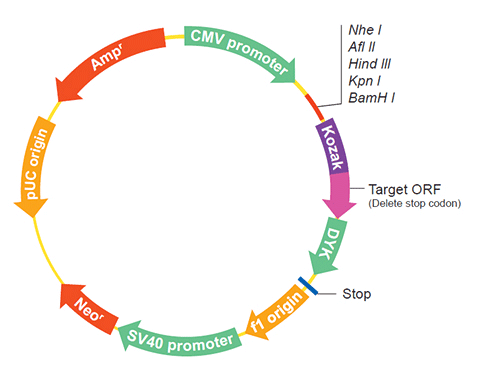| Gene Symbol | YNL146C-A |
| Entrez Gene ID | 1466510 |
| Full Name | hypothetical protein |
| Gene Type | protein-coding |
| Organism | Saccharomyces cerevisiae S288C |
HOME
ORF » Species Summary » Saccharomyces cerevisiae S288C » YNL146C-A cDNA ORF clone
| Gene Symbol | YNL146C-A |
| Entrez Gene ID | 1466510 |
| Full Name | hypothetical protein |
| Gene Type | protein-coding |
| Organism | Saccharomyces cerevisiae S288C |
| mRNA | Protein | Name |
|---|---|---|
| NM_001184663.1 | NP_878152.1 | hypothetical protein |


The nucleotide sequence of Saccharomyces cerevisiae chromosome XIV and its evolutionary implications.
Philippsen P, Kleine K, P?hlmann R, D?sterh?ft A, Hamberg K, Hegemann JH, Obermaier B, Urrestarazu LA, Aert R, Albermann K, Altmann R, Andr? B, Baladron V, Ballesta JP, B?cam AM, Beinhauer J, Boskovic J, Buitrago MJ, Bussereau F, Coster F, Crouzet M, D'Angelo M, Dal Pero F, De Antoni A, Del Rey F, Doignon F, Domdey H, Dubois E, Fiedler T, Fleig U, Floeth M, Fritz C, Gaillardin C, Garcia-Cantalejo JM, Glansdorff NN, Goffeau A, Gueldener U, Herbert C, Heumann K, Heuss-Neitzel D, Hilbert H, Hinni K, Iraqui Houssaini I, Jacquet M, Jimenez A, Jonniaux JL, Karpfinger L, Lanfranchi G, Lepingle A, Levesque H, Lyck R, Maftahi M, Mallet L, Maurer KC, Messenguy F, Mewes HW, M?sti D, Nasr F, Nicaud JM, Niedenthal RK, Pandolfo D, Pi?rard A, Piravandi E, Planta RJ, Pohl TM, Purnelle B, Rebischung C, Remacha M, Revuelta JL, Rinke M, Saiz JE, Sartorello F, Scherens B, Sen-Gupta M, Soler-Mira A, Urbanus JH, Valle G, Van Dyck L, Verhasselt P, Vierendeels F, Vissers S, Voet M, Volckaert G, Wach A, Wambutt R, Wedler H, Zollner A, Hani J
Nature387(6632 Suppl)93-8(1997 May)
Life with 6000 genes.
Goffeau A, Barrell BG, Bussey H, Davis RW, Dujon B, Feldmann H, Galibert F, Hoheisel JD, Jacq C, Johnston M, Louis EJ, Mewes HW, Murakami Y, Philippsen P, Tettelin H, Oliver SG
Science (New York, N.Y.)274(5287)546, 563-7(1996 Oct)
GeneRIFs: Gene References Into Functions What's a GeneRIF?
The following YNL146C-A gene cDNA ORF clone sequences were retrieved from the NCBI Reference Sequence Database (RefSeq). These sequences represent the protein coding region of the YNL146C-A cDNA ORF which is encoded by the open reading frame (ORF) sequence. ORF sequences can be delivered in our standard vector, pcDNA3.1+/C-(K)DYK or the vector of your choice as an expression/transfection-ready ORF clone. Not the clone you want? Click here to find your clone.
| CloneID | OSi05787 | |
| Clone ID Related Accession (Same CDS sequence) | NM_001184663.1 | |
| Accession Version | NM_001184663.1 Latest version! | Documents for ORF clone product in default vector |
| Sequence Information | ORF Nucleotide Sequence (Length: 195bp) Protein sequence SNP |
|
| Vector | pcDNA3.1-C-(k)DYK or customized vector |  User Manual User Manual |
| Clone information | Clone Map |  MSDS MSDS |
| Tag on pcDNA3.1+/C-(K)DYK | C terminal DYKDDDDK tags | |
| ORF Insert Method | CloneEZ™ Seamless cloning technology | |
| Insert Structure | linear | |
| Update Date | 2019-10-31 | |
| Organism | Saccharomyces cerevisiae S288C | |
| Product | hypothetical protein | |
| Comment | Comment: REVIEWED REFSEQ: This record has been curated by SGD. This record is derived from an annotated genomic sequence (NC_001146). ##Genome-Annotation-Data-START## Annotation Provider :: SGD Annotation Status :: Full Annotation Annotation Version :: R64-2-1 URL :: http://www.yeastgenome.org/ ##Genome-Annotation-Data-END## COMPLETENESS: incomplete on both ends. | |
1 | ATGATCTCAG TTTGTTTCGT TTTTCCTCAT TCTCTGGCTT TAGACTTCAA ATCGCGGTGT |
The stop codons will be deleted if pcDNA3.1+/C-(K)DYK vector is selected.
| RefSeq | NP_878152.1 |
| CDS | 1..195 |
| Translation |

Target ORF information:
Target ORF information:
|
 NM_001184663.1 NM_001184663.1 |

1 | ATGATCTCAG TTTGTTTCGT TTTTCCTCAT TCTCTGGCTT TAGACTTCAA ATCGCGGTGT |
The stop codons will be deleted if pcDNA3.1+/C-(K)DYK vector is selected.
The nucleotide sequence of Saccharomyces cerevisiae chromosome XIV and its evolutionary implications. |
Life with 6000 genes. |